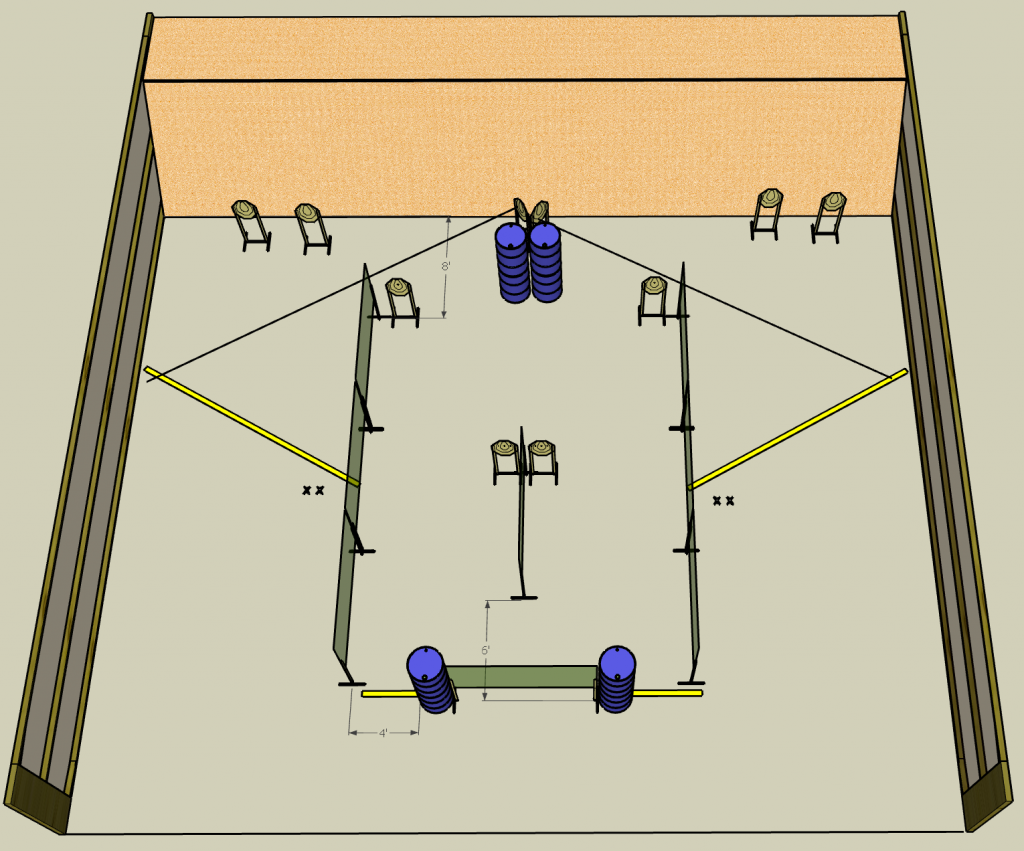For the first of what I intend to be a recurring series, I want to talk through interesting stages and break down what I think we can learn from each one.
First up, we have this stage that I designed for the January 2021 USPSA match at Sir Walter Gun Club. Here’s the screenshot I sent (along with the sketchup file) to the build team:

The yellow lines are the fault lines, and the pairs of Xs on the ground are steel markers we stake into the ground as a start position.
Options
Usually when people talk about options in USPSA stage design, they mean having multiple viable orders to go between all the different shooting positions in the stage. If you have to go to four different places, being able to go A, B, C, then D, or C first, then D, then B, then A.
In the context of this stage, nominally that would be accomplished by putting the start position somewhere at the back center of the stage. Voila: you have the option to go left or right first. But most of us know that the righties will mostly just shoot left to right and the lefties vice versa. Options in concept, but no meaningful choice.
That’s not the kind of options that this stage provides. You can start on the left or right Xs, but that’s only to avoid an advantage for righties or lefties.
Instead, every shooter went to the same shooting positions in the same order. The options this stage presented were primarily when and were to shoot at the two outside open targets against the back berm, and secondarily how aggressively to move and how much to slow down to shoot in each position.
Right off the draw, you had two close-range targets you could shoot on the move to the first defined “position”, shooting the target tucked behind the barrel on the side you started on. Or if you wanted to be more conservative, you could move to that position and shoot all six shots flat footed. Or you could choose some balance in the middle, like shooting one target while you were settling in and shooting the other two totally stable.
When to start shooting and how hard to make the shots on yourself was the challenge. Likewise on the other side, moving forward with two open targets looking straight at you. Do you move and set up, or shoot them on the move?
And then the targets in the middle were both inside 7 yards. Not hard shots at all. All the difficulty came from how much speed you carried into those positions and how much you wanted to slow down to engage them. Making them easy shots made them tempting to disrespect.
I don’t have a term for these smaller options, where you essentially choose your own difficulty on each target. But I personally think they make for very interesting stages.
Here’s my run on the stage (third person video slightly clipped due to technical problems):
And here’s a CO run by Richard Banks, who chose to move while drawing and shoot backing out of the first position:
Start position
The start position was deliberately chosen to make the options for engaging the first three targets different from the last three. If you started at the back of the stage and had to move forward down both the left and right side of the stage, you would shoot both sides the same way; I wanted to avoid that.
I wanted the shooter to have options whether to draw and immediately shoot while moving or move to the first position and then shoot. This choice would then be totally different from the choice of how to engage the last three targets while advancing.
Round Count
The round count for the stage was 20, which is a good Medium Course length. It means anyone in CO or Limited can shoot the stage without a reload, but only if they don’t need too many makeup shots. (A mini-popper or two can increase the risk of needing makeups quite a bit, making the risk/reward of planning to reload or not more interesting. While I would have loved to have some, there was nowhere to put steel in this stage the way it was designed.)
For Production and Single Stack Minor, you could shoot 6-8-6 or 10-10, another interesting risk/reward tradeoff. Single Stack Major and Revolver obviously would just reload between each position.
Target Selection
I specifically chose to use all open targets with no partials to encourage shooters to push the limits of speed. Ironically I caught myself out at the third position, racking up two deltas because I wasn’t gripping the gun enough to return it for the second shot on each target. But that was exactly the intent; adding hard cover or no-shoots to the targets would just signal to shooters that they need to slow down and be careful, when this whole stage is about encouraging them to go as fast as they can while still getting points.
Logistics
This stage worked out especially well given the bay it was in is both relatively small side-to-side (approximately 18 yards wide) and only has the rear backstop. Also, all rounds have to impact the backstop; no rounds can hit the range floor.
With those constraints, it can be easy to have stages without very much movement or where all the shots are straight downrange, and so I was happy to have such a fast-paced stage that required a lot of movement–while still not being simply a question of footspeed.
Additionally, it only required target stands and full-size walls, with a few barrel stacks that could easily be half-walls if needed. Sir Walter is blessed to have a lot of interesting props to use, but it’s nice when a simple stage doesn’t require them to be interesting.
You might need to play with the angles and the lengths of each wall, but this general stage concept should be adaptable to almost any single-berm bay, including indoor ranges.
